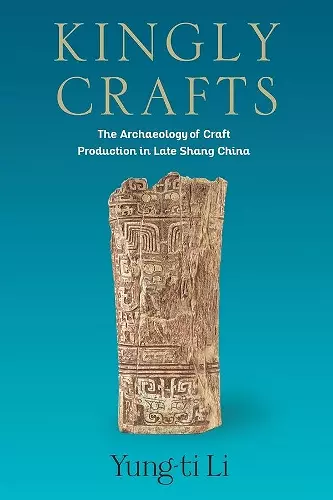Kingly Crafts
The Archaeology of Craft Production in Late Shang China
Format:Hardback
Publisher:Columbia University Press
Published:10th Jan '23
Should be back in stock very soon

The site of Anyang, the last capital of the Shang dynasty, dated to around 1200 to 1000 BCE, is one of the most important sources of knowledge about craft production in Bronze Age China. Excavations and research of the settlement over the past ninety years demonstrate both the advanced level of Shang craft workers and the scale and capacity of the craft industries of the time. However, materials unearthed in Anyang by different expeditions have since been stored separately in China and Taiwan, making a thorough study of this important aspect of life in Shang China challenging. Despite efforts to integrate the data based on published material, the physical evidence rarely has been considered as a single group.
Through a systematic analysis of the archaeological materials available in both China and Taiwan, Yung-ti Li provides a detailed picture of craft production in Anyang and paves the way for a new understanding of how the Shang capital functioned as a metropolis. Focusing on craft-producing activities, including bronze casting, bone working, shell and marble inlay working, lithic working, and pottery production, Kingly Crafts examines the material remains, the technology, and the production organization of the craft industries. Although the level of Shang craftsmanship can be seen in the finished products, Li demonstrates that it is necessary to study workshop remains and their archaeological context to reconstruct the social and political contexts of craft production. Offering a comprehensive investigation of these remains, Kingly Crafts sheds new light on the relationships between craft industries and political authority in the late Shang period.
I believe this work to be of great significance to the field. Nothing like it has been published on early China in English, and it establishes the groundwork for future synthetic studies of Shang craft working and economy. Kingly Crafts will be used as an authoritative work for many years to come. -- Roderick B. Campbell, author of Violence, Kinship, and the Early Chinese State: The Shang and Their World
Yung-ti Li sifts through a century’s worth of archaeological data to reconstruct the most up-to-date blueprint for the Shang dynasty’s last capital as a complex and likely planned urban environment—one that integrates layers of elite and nonelite craft production precincts. His vision is fresh and clear-eyed on what the material cultural record can or cannot really tell us—unafraid to question a few of the favored historical-cultural myths. -- Constance A. Cook, author of Ancestors, Kings, and the Dao
This is a much-anticipated synthetic study of craftworking at Anyang focusing on the ‘kingly crafts,’ especially bronze, bone, ivory, shell, and marble. With masterly command of available archaeological data accumulated from ninety years of field investigation and in graceful prose, Li skillfully brings to life the large-scale craft workshop tradition that served the high elite. -- Katheryn Linduff, University of Pittsburgh
Anyang has been excavated every year for nearly a century, and yet the last book-length study in a European language is forty-five years old. Li’s book brings the study of the last capital of the Shang dynasty, the most important location for understanding Chinese civilization at the end of the second millennium BCE, into the twenty-first century. The political and ritual center is shown to be a unique urban nexus of an elite population. Using bronze vessels and inscribed bones, as well as jade, turquoise, lacquer, shells, and wild and exotic animals, Li reconstructs the inner workings of Shang society as only a scholar who is also an excavator can. -- Nancy Shatzman Steinhardt, author of The Borders of Chinese Architecture
Kingly Crafts is a rich and comprehensive study of craft and art works excavated at Anyang, the last royal center of the Shang Dynasty. Most noteworthy about the book is the variety of crafts it considers. A substantial work. -- Ying Wang, University of Wisconsin, Milwaukee
The writing style is accessible, and the illustrations and data charts are of good quality and well-presented. I would highly recommend this book both to scholars and students of Shang/Chinese archaeology and those interested in exploring comparative studies of craft production in early civilisations. * Antiquity *
ISBN: 9780231192040
Dimensions: unknown
Weight: unknown
280 pages